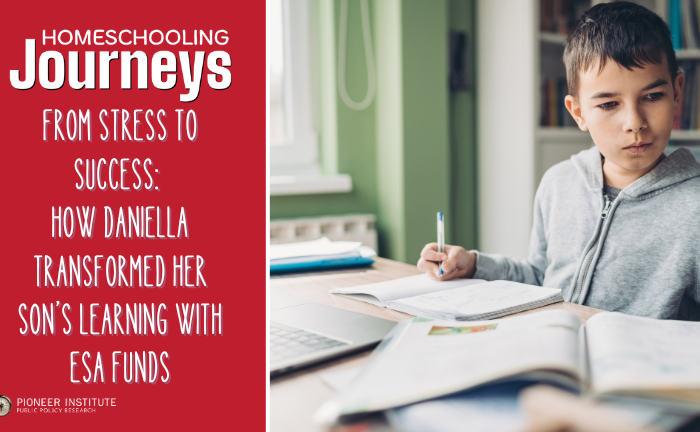From Stress to Success: How Daniella Transformed Her Son’s Learning with ESA Funds
Welcome to Homeschooling Journeys with Daniella Moreci-Pack
How does Daniella spend her Arizona Education Savings Account?
-Special needs therapies for ADHD and social skills
-Curriculum products like: dissection kits, math Manipulatives, book about Anne Frank for a young reader (not her diary)
– In person karate classes
– In person dance classes
I’ve found this to be a common pattern.
The first dollars are for “stuff.”
Second, special needs services, if needed.
Next, in-person and social enrichment experiences – art, music, physical activity.
Four themes in this episode.
1. Daniella is an “Aspirin Parent” in my parlance.
The pain she felt was her kid in school during Covid. “It was not worth the stress that it was putting on him or me.”
She went into Mama Bear mode, pulled him out of school, and then….took the leap into homeschooling.
“I had a ton of anxiety about whether I was doing the right thing. Can I do this?”
2. Homeschoolers, at first, often replicate the schedule/vibe of regular school….then stop.
Daniella says: “I tried to do structure at the very beginning (of homeschooling) and I was feeling it was very public school-y. What I was trying to do? I had to redirect myself and say, ‘Hey, we took him out of that environment because it wasn’t working. Why are you trying to replicate it here?’”
“It’s pretty child-led here. He pretty much tells me what he feels like today and we kind of work around that…..I do have (topics) that I do want to teach him. I just let him tell me how he wants to learn it.
I had a parent who does not homeschool say to me, why is (your 3rd grader) already doing dissection (as a young student)? I’m like, because that’s what he’s interested in and that’s what he wants to do. So we’re doing it at a lower level right now. It doesn’t have to be in 7th grade.”
Maria Montessori would approve. Daniella is free to invert what happens in normal schools. When I was a charter school leader, we had a list of topics that the Massachusetts Department of Education wanted us to teach each year. Those were non-negotiable.
By contrast, Daniella first scans for motivation, keeping the to-do list in the back of her head….we’ll get to X topic eventually. This frees her to be opportunistic. Family trip to Germany and Netherlands is coming up? Mom and son read a book about Anne Frank and will visit Anne Frank’s House.
3. Red Tape for the Education Savings Accounts
“I went on the ESA Facebook groups,” Daniella recalls. “I was like, has anybody used this ’History Unboxed?’ Does anybody like it? I got a couple of warnings from people. That this curriculum includes food in their boxes and food is absolutely a non allowable in ESA (technical rule).
But the vendor does have an option on their website that says, please don’t include any food in this box. So I ordered that version – it’s basically a box a month. It’s great!”
In this case, the red tape was no big deal. Yes, it’s silly. Daniella had to click a box to tell the vendor something like: “Don’t put the teabags in with Boston Tea Party box, even though any reasonable human being would think that’s obviously an education expenditure, not Daniella’s family trying to get free food and bilk the taxpayers of Arizona.”
But in the past few months, Arizona ESA red tape is surging. Opponents of ESAs have scored a political victory here.
Daniella describes a new rule, where every item needs its own “curriculum.” The rule itself is poorly defined, but seems to mean that “if we want to purchase paper, pens, art supplies, crayons, markers, those things now also need a curriculum.”
My take: This is attaching a rule that only applies homeschooling parents. It’s not true in a public school. When I ran a school, we could buy all the crayons we wanted. We never had to say, these 18 boxes of crayons are going to be for math class coloring in first grade.
4. Curious Mike’s emerging view (open to correction!)
ESAs have political backers and opponents. The opponents’ playbook is similar to their fight against charter schools:
-Find questionable expenses; get friendly news outlets to run negative headlines – ESAs Gone Wild
-Introduce red tape to deter vendors, particularly solo teachers or therapists or edupreneurs like Alicia from Episode 1, from accepting ESA payments, and deter homeschoolers from using them
-File lawsuits (in a future episode, Katie will tell us of her court experience in West Virginia)
Robert Enlow of EdChoice is right. Via Chalkbeat: “Passing strong ESA laws is hard, but implementing these programs with excellence is harder,” Enlow said. “The details of implementation have to be done well.”
I’m fascinated by these details of implementation. When I scan ESA-related Facebook groups around the country, I see wide variation in the level/intensity of complaints about the bureaucratic process of reimbursement.
* * *
Daniella strikes me as a no-nonsense, get-it-done Mom – I admire her courage to just jump in and roll with the punches. You’ll enjoy meeting her, give it a listen.
Tell us what you liked and didn’t about the episode! You can email me at MGoldstein@pioneerinstitute.org.



